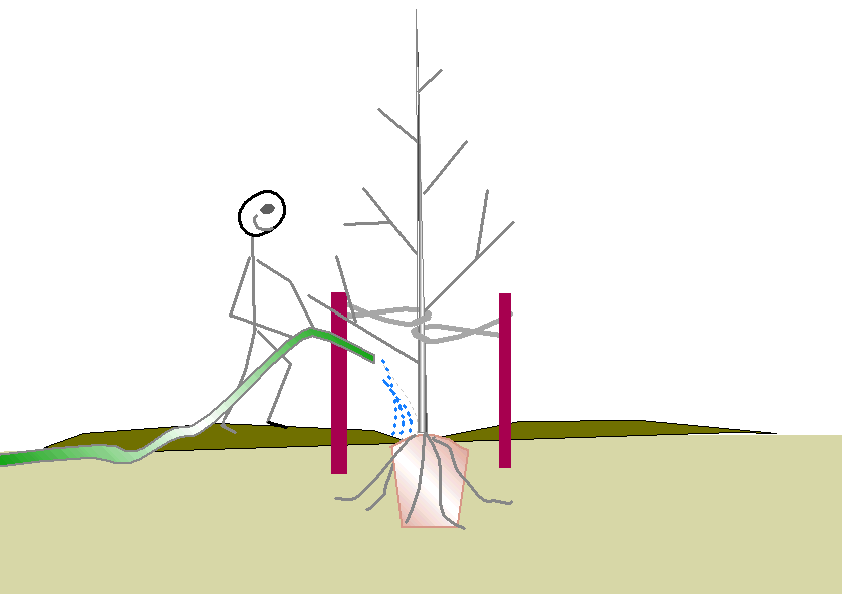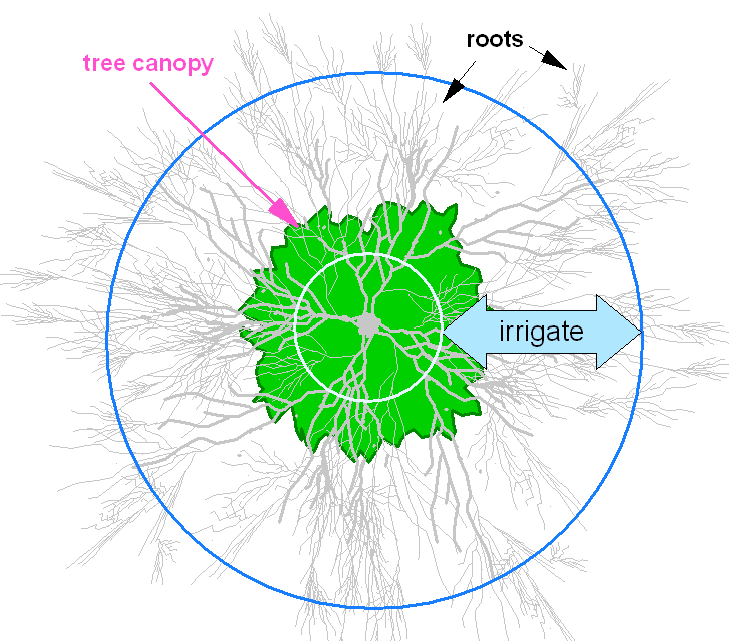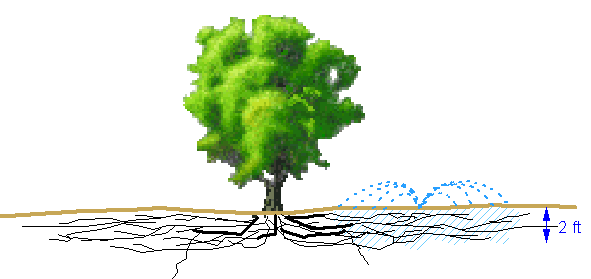How to water your tree
Download a printer friendly (Adobe Acrobat PDF) version of this document
Where to irrigate
The best place to apply water differs for newly planted and established trees.

Newly planted trees: Immediately after planting, all tree roots are in the original root ball area. Until new roots grow into the soil of the planting site, water the original root ball area and just beyond this area. The root ball area may dry out faster than the surrounding soil, so check the moisture in this area frequently for the first month or two after planting. See How to plant a new container-grown tree for more details on watering newly-planted trees.
A newly planted tree may take 1-2 years to become established. Larger container stock trees may take longer to become established than smaller stock.
 Established trees: Don't irrigate the area directly adjacent to
the trunk - this can increase the risk of disease. Roots extend far beyond
the edge of canopy or drip line. Water in the outer half of the area under
the canopy and beyond the edge of the canopy.
Established trees: Don't irrigate the area directly adjacent to
the trunk - this can increase the risk of disease. Roots extend far beyond
the edge of canopy or drip line. Water in the outer half of the area under
the canopy and beyond the edge of the canopy.
How to irrigate
You can apply water effectively using sprinklers, drip irrigation, or a hose
running on the soil surface. Regardless of how you apply the water, follow these
basic rules.
 Water deeply rather than frequently. Because most tree
roots are found in the upper 18 - 24 inches of the soil, this is the zone
that should be wetted up in each irrigation cycle. Each deep irrigation
will meet a tree's water needs for between 10 days to 4 weeks during the
hottest part of the summer, depending on the tree species and soil type.
Water deeply rather than frequently. Because most tree
roots are found in the upper 18 - 24 inches of the soil, this is the zone
that should be wetted up in each irrigation cycle. Each deep irrigation
will meet a tree's water needs for between 10 days to 4 weeks during the
hottest part of the summer, depending on the tree species and soil type.
Stop watering when runoff starts. Soils high in clay accept water slowly, often as little as 1/4 inch per hour. Water infiltration is especially slow in compacted soils. If water starts to pool or run off, stop irrigating, let the water soak in, and start watering again. Repeat on/off cycles until you apply enough water to wet the soil to 18-24 inches. This may take a number of cycles over several consecutive days.
Don't saturate the soil for long periods. Water displaces air in the soil, so long periods of soil saturation can suffocate growing roots. Take a long enough break between irrigation cycles to allow the free water to be absorbed. If in doubt, probe or dig to make sure that the soil isn't soggy below the surface.
How much water does my tree need?
Tree irrigation needs change over time. The amount of irrigation your tree will need can be affected by:
Tree age - A newly planted tree will need more frequent irrigation than an established tree because its root system is more limited.
Root damage - An established tree that suffers root loss or damage (for instance, due to trenching within the root zone) may need additional irrigation until new roots grow to replace those that are destroyed.
Time of the year - The need for irrigation is greatest in mid to late summer, when temperatures are the highest and most of the moisture stored in the soil over the winter has been depleted.
Weather conditions - In drought years, soil moisture is used up earlier in the season, so the period of peak water need is longer. Some trees that do not normally need irrigation may benefit from irrigation in drought years. In very wet years, irrigation may not be needed until early summer or later.
Soil conditions - Water used by trees is stored in the soil. Soil type, depth, and condition influence how much water can be stored in the soil, and consequently how often you may need to water. Soils that have more clay hold more water and can be irrigated less frequently. Sandy soils hold relatively little water and need more frequent irrigation.
Species - Some tree species require no additional irrigation once established, whereas others will do poorly without consistent irrigation throughout the summer.
Water requirements of established trees under and typical Vacaville weather conditions and soils
| Category | Summer watering interval* | Tree species |
|---|---|---|
| Low | Once per month |
Chinese pistache (Pistachia chinensis)** |
| Moderate | Twice per month | Chinese flame tree (Koelreuteria bipinnata) Flowering Pear (Pyrus calleryana cultivars including 'Aristocrat'**) Hedge maple (Acer campestre) Incense cedar (Calocedrus decurrens) London Plane tree (Platanus acerifolia)** Stone fruits - apricot, cherry, peach, plum, nectarine (Prunus species) |
| High | Three times per month | Coast redwood (Sequoia sempervirens)** Birch (Betula species) |
*assumes that soil in the root zone is wetted to a depth of 18 to 24 inches
at each irrigation
** species included in the Vacaville Trees 2000 residential tree giveaway program